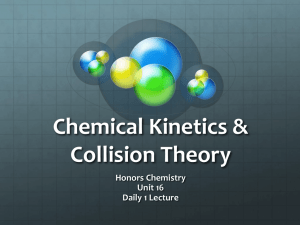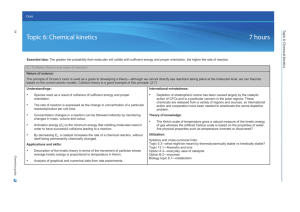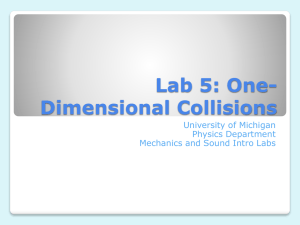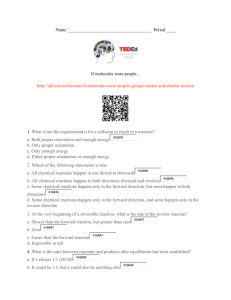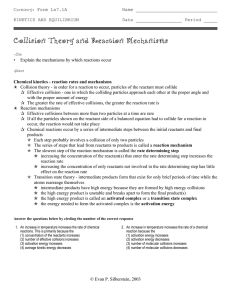Collision Rates for Many Body Encounters A A Agbormbai
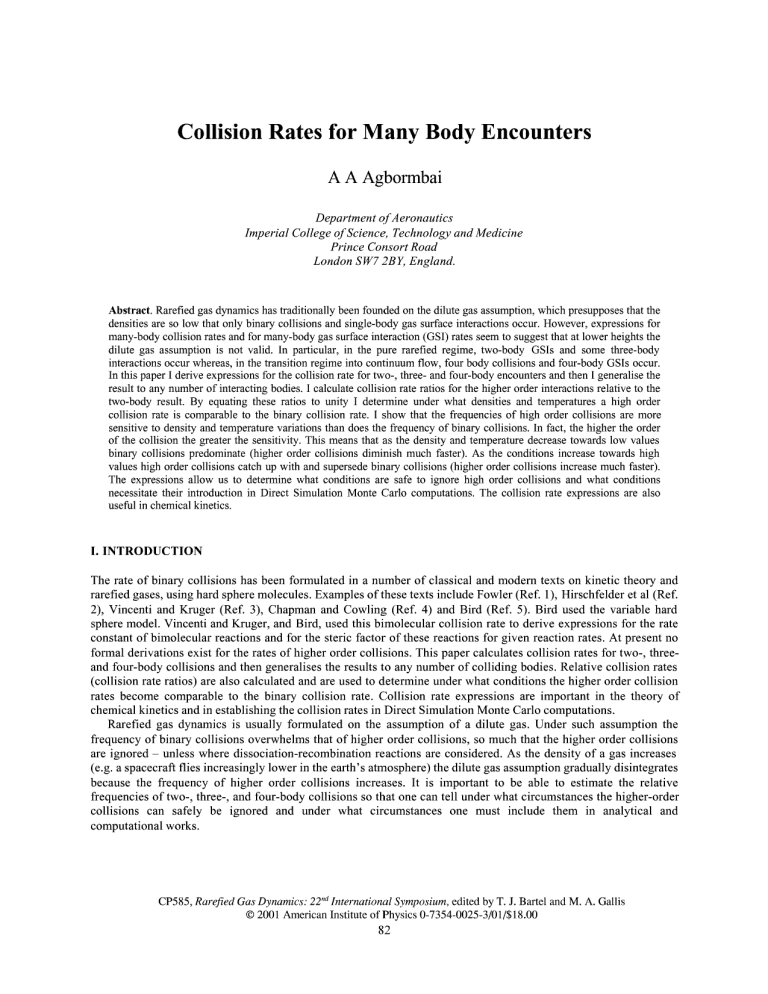
Collision Rates for Many Body Encounters
A A Agbormbai
Department of Aeronautics
Imperial College of Science, Technology and Medicine
Prince Consort Road
London SW7 2BY, England.
Abstract. Rarefied gas dynamics has traditionally been founded on the dilute gas assumption, which presupposes that the densities are so low that only binary collisions and single-body gas surface interactions occur. However, expressions for many-body collision rates and for many-body gas surface interaction (GSI) rates seem to suggest that at lower heights the dilute gas assumption is not valid. In particular, in the pure rarefied regime, two-body GSIs and some three-body interactions occur whereas, in the transition regime into continuum flow, four body collisions and four-body GSIs occur.
In this paper I derive expressions for the collision rate for two-, three- and four-body encounters and then I generalise the result to any number of interacting bodies. I calculate collision rate ratios for the higher order interactions relative to the two-body result. By equating these ratios to unity I determine under what densities and temperatures a high order collision rate is comparable to the binary collision rate. I show that the frequencies of high order collisions are more sensitive to density and temperature variations than does the frequency of binary collisions. In fact, the higher the order of the collision the greater the sensitivity. This means that as the density and temperature decrease towards low values binary collisions predominate (higher order collisions diminish much faster). As the conditions increase towards high values high order collisions catch up with and supersede binary collisions (higher order collisions increase much faster).
The expressions allow us to determine what conditions are safe to ignore high order collisions and what conditions necessitate their introduction in Direct Simulation Monte Carlo computations. The collision rate expressions are also useful in chemical kinetics.
I. INTRODUCTION
The rate of binary collisions has been formulated in a number of classical and modern texts on kinetic theory and rarefied gases, using hard sphere molecules. Examples of these texts include Fowler (Ref. 1), Hirschfelder et al (Ref.
2), Vincenti and Kruger (Ref. 3), Chapman and Cowling (Ref. 4) and Bird (Ref. 5). Bird used the variable hard sphere model. Vincenti and Kruger, and Bird, used this bimolecular collision rate to derive expressions for the rate constant of bimolecular reactions and for the steric factor of these reactions for given reaction rates. At present no formal derivations exist for the rates of higher order collisions. This paper calculates collision rates for two-, threeand four-body collisions and then generalises the results to any number of colliding bodies. Relative collision rates
(collision rate ratios) are also calculated and are used to determine under what conditions the higher order collision rates become comparable to the binary collision rate. Collision rate expressions are important in the theory of chemical kinetics and in establishing the collision rates in Direct Simulation Monte Carlo computations.
Rarefied gas dynamics is usually formulated on the assumption of a dilute gas. Under such assumption the frequency of binary collisions overwhelms that of higher order collisions, so much that the higher order collisions are ignored - unless where dissociation-recombination reactions are considered. As the density of a gas increases
(e.g. a spacecraft flies increasingly lower in the earth's atmosphere) the dilute gas assumption gradually disintegrates because the frequency of higher order collisions increases. It is important to be able to estimate the relative frequencies of two-, three-, and four-body collisions so that one can tell under what circumstances the higher-order collisions can safely be ignored and under what circumstances one must include them in analytical and computational works.
CP585, Rarefied Gas Dynamics: 22 nd
International Symposium, edited by T. J. Bartel and M. A. Gallis
© 2001 American Institute of Physics 0-7354-0025-3/01/$18.00
82
II. TWO-BODY COLLISION RATE
We formulate an expression for the binary collision rate and then generalise it to many body collisions. Let us invoke a transition probability R per unit time to describe the collision. The transition probability is such that the probability of a forward encounter in time interval t to t + dt is:
R\£f\CjdC'dt where single primes denote the pre -collision state and double primes denotethe post- collision state where:
C = (c,,c
2
)
The transition probability is non-negative and is normalised in the manner: where the integration is taken over all velocities.
By formulating the statistics in an elementary control volume dr = dx dy dz and in a time interval dt we can show that the collision rate (i.e. the number of forward encounters made per unit volume per unit time) is: dX
2
= F (C f y)RC\C'dCdC f
(1)
Write:
F w(2)
(C',r') = F^c^r')F w2
(4,r') = n^f,(<:{)Xn
2
(r')f
2
(c'
2
) (molecular chaos)
R(p\C")dC' = R^^dg" = g'a"d£l" (astandard monatomic gas result) f
f X exp -—— (for equilibrium results)
I 2A:r J
(7 r
= crlE/Q^ (total collision cross-section) o
The collision rate becomes:
( «1 fV «2 ^ , f
£
\ , ' ^ ' 1, !, '2 ^
^2 = «i«2| 7T3^ I i T Z r ^ l g ^ r ^ P l - T ^ P c i rfc
2
where
e = 'j('«ici +/w
2 c
2
) (2)
Introducing centre of mass co-ordinates and transforming into spherical co-ordinates we get: dx nn 0 G
>*
e
^ - g ^ e
^ - d t ? y g
/ r f £ ^ r f a ' , M
2
=m l +
m
2
(3)
2 l
\27tiT) {27zkT)
T
^\ 2kT I
5
^1 2kT \
We can now integrate over all angles and over all speeds to get the total collision frequency per unit volume per unit time. This is:
X
2
= W
T
—— (4)
83
Thus, the total collision rate increases with the density and temperature but decreases with the mass of the reduced particle. The collision rate is sensitive to the square of the density, but sensitive only to the half-power of the temperature.
III. GENERALISATION TO MANY BODIES
First we derive an expression for three-body collisions, then we write down the expression for four-body collisions, and finally we generalise to TV-body collisions. For three body encounters the collision frequency per unit volume per unit time is: dX, =
W2
/oCc^/iCcO/^) g{aytt{g'
2 e'
2 d£l"
2
d^dt\dt'
2
(5) where the result has been expressed in terms of the scattering of two reduced particles. Invoke the equilibrium distribution as usual and transform to the centre of mass reference frame. The kinetic energy in the centre of mass frame is (Ref. 6):
,
2 2 M
3
2 M
3
In actual fact, the kinetic energy in the centre of mass frame contains cross terms that represent the dynamic interaction among the reduced particles. These are scalar product terms. However, interaction problems are formulated in the phase space of the interaction and the molecular velocities of the interaction contribute to the dimensions of this phase space. Therefore, within the phase space the molecular velocities of the interaction are orthogonal to one another. If we transform these velocities to the centre of mass frame it follows that the velocities of the reduced particles will be orthogonal to one another as well as to the centre of mass velocity. Hence the cross terms in the kinetic energy become zero. We formulate the collision rate as the number of phase points per unit physical volume making a forward transition into all angles and energies in unit time.
Invoking the equilibrium distribution, using the kinetic energy relationship, introducing the total cross section for scattering of each reduced particle, and finally transforming to spherical co-ordinates, we get: dX
3
= « oWl
«
2
— J- —L- —L- a n a
T2
G'
2
exp ——*—— (6)
\2nkT j \2nkT j \2nkT j I 2kT I
( ..(3) ,1 \ ( (3) /2 \ xgfexp -^L|_ L'exp -fffflL&_ IdG'dg^d^d^d^
(
2kT
) (
2kT
) where [iff = — ^ — - —— — , n$ = — — — - —— — are the three - body reduced masses of the particles.
M
3
M
3
Integrating over all angles and over all speeds we get the total collision rate as:
(7)
This result can be easily generalised to any number of interacting bodies. For four bodies the collision rate is:
(8) where
^(4)^(^4-™!),
M
4
M
4
M
4 are the four -body reduced masses of the particles andM
4
=m
Q
+m l
+m
2
+m
3>
84
For Nbodies the collision rate is:
(9) where
(M -
— —— — ——
MN
M
N
= are
the TV -body reduced masses of the particles.
IV. COLLISION RATE RATIOS
To determine under what conditions higher order collisions become important in rarefied gas dynamics we need to establish collision rate ratios relative to the standard binary collisions. To calculate collision ratios we simplify the analysis by assuming that we are dealing with a single species of gas. The masses are then identical and the same potential function acts between the particles. As the same potential acts between the particles we can reasonably assume that the total cross sections of the reduced particles are identical. Furthermore, we assume that the total cross sections are equal to the two-body result. Under these assumptions the collision rate ratios are:
(8kT\
X
= n
N
-
2 a%-
2
These relationships show us that as the density, temperature and total cross section increase, while the molecular mass decreases, the collision rate increases. Higher order collisions increase at an ever-faster rate. The higher the order of the collisions the more sensitive is the collision rate to changes in the density, temperature, total cross section and molecular mass. The results suggest that the influence of many body collisions in rarefied gas dynamics may be more significant than has been assumed in the past. As the transition is made from rarefied gas dynamics to continuum flow (i.e. from outer atmospheric flight at low densities to continuum hypersonic flight at high densities) the effects of many body collisions become severe. This is shown in Figure 1, which depicts a new look to rarefied gas dynamics in terms of different flow regimes. The flow regimes are classified in terms of the typical order of molecular collisions that occur in the gas. The increasing effects of many body collisions in lower level rarefied flows suggests that DSMC computations should be extended to accommodate higher order collisions and higher order gas surface interactions - especially when approaching the transition into continuum flows.
Using the above results we can estimate under what conditions of density and temperature we can justifiably include three-body, four-body and higher order interactions in DSMC simulations. Of course, in a given gas, lower order and higher order interactions occur together but at different rates. At low densities and temperatures low order interactions (especially binary interactions) predominate. As the density and temperature increase towards high values the frequencies of higher order interactions increase faster than the frequencies of low order interactions.
Thus, higher order interactions catch up with and supersede the low order interactions. We can find the conditions at which the high order interactions catch up with the low order interactions by equating the collision rate ratios to unity and solving for the density and temperature conditions. Note that the greater sensitivity of high order collision rates to density and temperature means that, as these conditions decrease towards low values, the high order collision rates will diminish faster than the low order collision rates - hence the predominance of low order collisions at low densities and temperatures. On the other hand, as the conditions increase, the high order collision rates will increase faster than the low order collision rates - hence the predominance of high order interactions at high densities and temperatures.
(10)
85
No atmosphere
Height
No collisions
Mainly binary collisions, with some three-body collisions especially at lower levels
Mainly threeand four-body collisions
Five or more body collisions
Figure 1 Flow regimes in gas dynamics, and the influence of high order collisions. At free molecular flow there are no collisions; at pure rarefied flow binary collisions predominate, but three-body collisions become important at lower levels especially close to the transition regime; at transition flow three- and four-body collisions are predominant, with some two-body collisions occurring; finally at continuum flow high order collisions predominate.
The conditions at which the frequencies of high order collisions are comparable to that of binary collisions are as follows:
Four - body collisions: Three - body collisions : na
T
IT
\m
(11)
N - body collisions : i
(N-
•.27V-2 m
REFERENCES fowler R H (1929), "Statistical Mechanics", McGraw-Hill, New York.
2
Hirschfelder J O, Curtiss C F, and Bird R B, The Molecular Theory of Gases and Liquids, Chapman and Hall, London (1954).
3
Vincenti W. G. and Kruger C. H. (1965), "An Introduction to Physical Gas Dynamics", p357, Robert and Krieger, New York.
4
Chapman S and Cowling T G (1970), "The Mathematical Theory of Non-uniform Gases", 3 rd
ed., Cambridge University Press.
5
Bird (1994), "Molecular Gas Dynamics and the Direct Simulation of Gas Flow", Clarendon Press, Oxford.
6
Agbormbai A. A., Dynamical and Statistical Modelling of Many Body Collisions Part I: Scattering, submitted to Rarefied Gas
Dynamics, 22 nd
symp.
86


